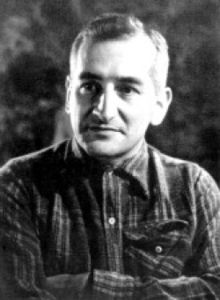Hector German Oesterheld
| Héctor Germán Oesterheld | |
|---|---|

Oesterheld in 1957
|
|
| Born | Héctor Germán Oesterheld July 23, 1919 Buenos Aires, Argentina |
| Died | 1977 (age 58) Buenos Aires (presumed) |
| Area(s) | Writer Journalist |
| Pseudonym(s) | HGO H. Sturgiss C. de la Vega Francisco G. Vázquez Germán Sturgiss Héctor Sánchez Puyol Joe Trigger Patrick Hanson |
|
Notable works
|
El Sargento Kirk Ernie Pike El Eternauta Mort Cinder La Vida del Che |
| Spouse(s) | Elsa Sánchez |
Héctor Germán Oesterheld, also known as his common abbreviation HGO (born July 23, 1919; disappeared and presumed dead 1977), was an Argentine journalist and writer of graphic novels and comics. He has come to be celebrated as a master in his field and as one of the pioneering artists in Argentine modern comics.
Through his comics, Oesterheld criticized the numerous military dictatorships that beleaguered the country in different periods ranging from 1955 to 1983, as well as different facets of capitalism, colonialism and imperialism, choosing a subtle criticism in his early comics during the 50's and early 60's, and a stronger and direct approach in his later work, after the murder of Che Guevara in 1967, and onwards from then on: in 1968 he wrote a biographical comic of Che Guevara, which was subsequently banned by the Argentinian dictatorship ruling at the time.
During the Argentina's last civil-military dictatorship, he and his daughters joined the Montoneros, a leftist (and former peronist) guerrilla group that opposed the military junta. HGO continued to publish works in clandestine form while hidden in secret locations, but he was ultimately kidnapped and disappeared. His daughters were also arrested and disappeared, as were his sons-in-law. Only HGO's wife, Elsa, escaped the family's tragic fate.
Over the years, Oesterheld's legacy has become vast, influencing several generations of new artists, particularly in literature and comic books.
Oesterheld was born in Buenos Aires to a German father and a Basque mother. His early studies were in geology, which has been said to contribute to his acuity as a science fiction writer. He began his journalistic career in the early 1940s. His first work appeared in the daily La Prensa newspaper and then was published by Codex. He moved to Abril publishers, where he began his extensive career as a comics writer.
...
Wikipedia
